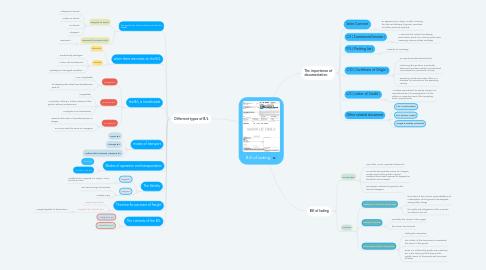
1. Differrent types of B/L
1.1. the good have been loaded on board the vessel
1.1.1. Shipped on board
1.1.1.1. "Shipped on board"
1.1.1.2. "Laden on board"
1.1.1.3. "on board"
1.1.1.4. "Shipped"
1.1.2. Received for shipment B/L
1.1.2.1. "Received"
1.2. when there are notes on the B/L
1.2.1. Clean B/L
1.2.2. Unclean
1.2.2.1. " insufficiently packages"
1.2.2.2. "carton old and stained"
1.2.2.3. "packages in damaged condition "
1.3. the B/L is transferable
1.3.1. Straight B/L
1.3.1.1. A non- negotiable
1.3.1.2. for shipping items that have already been paid for
1.3.2. To Bearer B/L
1.3.2.1. Negotiable
1.3.2.2. Any holder of the B/L to take delivery of the goods, without endorsement
1.3.2.3. consignee is not mentioned
1.3.3. To Oder B/L
1.3.3.1. issued to the order of specified person or assigns
1.3.3.2. DO NOT write the name of consignee
1.4. modes of transport
1.4.1. Direct B/L
1.4.2. Through B/L
1.4.3. Multimodal/Combined Transport B/L
1.5. Modes of operation and transportation
1.5.1. Liner B/L
1.5.2. Charter Party B/L
1.6. The Validity
1.6.1. OriginB/L
1.6.1.1. usually have 3 originals & 3 copies , have the same value
1.6.2. Copy B/L
1.6.2.1. Not owned cargo documents
1.6.2.2. multiple copy
1.7. The time for payment of freight
1.7.1. Freight prepaid B/L
1.7.2. Freight to be collected B/L
1.7.2.1. "Freight payable at destination"
1.8. The contents of the B/L
1.8.1. A long form B/L
1.8.2. A short form B/L
2. The importance of documentation
2.1. Sales Contract
2.1.1. an agreement w a buyer & seller covering the sale and delivery of goods, securities , and other personal property
2.2. C/I ( Commercial Invoice )
2.2.1. A document of content containing information about true value of good when assessing customs duties and taxes
2.3. P/L ( Packing list )
2.3.1. contents of a package
2.4. C/O ( Certificate of Origin )
2.4.1. an impotannt international trade
2.4.2. confirming the goods in a particular shipment have been wholly manufactured or processed in a particular country
2.4.3. issued by a trade promotion office or a chamber of commerce in the exporting country
2.5. L/C ( Letter of Credit )
2.5.1. A written commitment to pay by a buyer's or importer's bank ( the issuing bank ) to the seller's or exporter's bank ( the accepting bank , paying bank )
2.6. Other related document
2.6.1. A/N (Arrival Notice )
2.6.2. D/O (Deliver Order)
2.6.3. Weight & Quality Certificate
3. Bill of lading
3.1. Denification
3.1.1. one of the MOST important document
3.1.2. is a certificate issued by carrier to a shipper evidencing that the goods in good condition have been received or shipped on broad the named vessel
3.1.3. promising to deliver the goods to the named consignee
3.2. Fuctions
3.2.1. Evidence of Contract of Carriage
3.2.1.1. the extent of the carrier's responsibillity and a description of the goods to be shipped, among other things
3.2.1.2. the rights and obligations of the 2 parties are listed on the B/L
3.2.2. Receipt of goods
3.2.2.1. issued by the carrier or their agent
3.2.2.2. the carrier has received
3.2.3. Document of title to the goods
3.2.3.1. Stating the ownership
3.2.3.2. The holder of the document is considered the owner of the goods
3.2.3.3. when S.O collects the goods upon delivery, B/L is the only proof that they are the rightful owner of the goods and have paid for them

